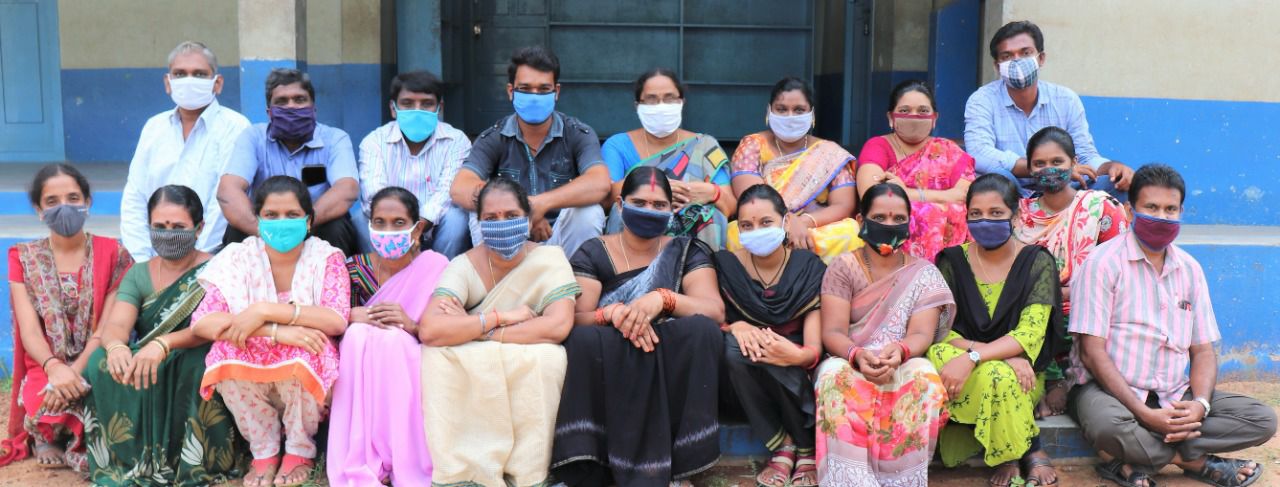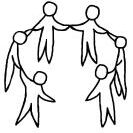
TANUKU COVID 19 PROJECT
Survey Findings: Kinder Care High School, Tanuku
As a Non-Governmental Organisation (NGO), with limited resources at our disposal, we have adopted a three-pronged strategy of reaching those most affected by the Pandemic. First, we have cooperated with Government Agencies in the distribution of provision and spreading awareness of safeguards. Second, we have provided ‘Provision Kit’ to all families of our students. As a special case, Provision Kit and Financial Assistance were distributed thrice to families that did not have necessary documents to claim benefits from the Government and those in dire distress. Third, we initiated a survey to (a). understand better the families of our students and (b). to ascertain how many of them lacked the necessary documents to benefit from various Government Welfare Programmes. This was with the intention of helping those lacking them to apply for the same.
The scope of the survey was limited to families of students currently studying in Kinder Care High School (KCHS) and/or families who are currently helped for higher education/vocational training under the ‘Life Assistance Programme’ (LAP). The study covered 296 families with 1170 respondents (and a student population of 449- 381 KCHS students and 68 LAP students).
All our teachers happily participated in every step of the survey: problem formulation, preparing survey questionnaire, pre-testing, visiting families to collect data, checking data for mistakes, data entry, short listing families that required follow up assistance, etc. We thank all staff for their wholehearted cooperation in conducting the survey and also for their selfless service in reaching out to the families of our students during these difficult times.
Findings of the Survey
Residence of Respondents
| Arundathi Peta | 291 (25%) |
| Undrajavaram | 226 (19%) |
| Tanuku Town | 162 (14%) |
| Iragavaram Colony | 120 (10%) |
| Indiramma Colony | 83 (7%) |
| Mortha | 73 (6%) |
| Palangi | 63 (5%) |
| Other | 152 (14%) |
| Total | 1170 (100%) |
A vast majority of our students and their families hail from 6 settlements/colonies; mostly inhabited by Scheduled Caste population. One-fourth of the respondents reside in Arundathi Peta; one of the oldest settlements in town. Thirty percent of the respondents are from Mortha, Undrajavaram and Palangi Villages. Iragavaram and Indiramma Colonies together constitute 17% of the respondents. Fourteen percent hail from various parts of Tanuku Town and the remaining 14% from smaller villages/streets.
Sex of the Respondent
| Female | 638 (55%) |
| Male | 532 (45%) |
| Total | 1170 (100%) |
A majority (55%) female population might surprise. However, there are many cases where the husband is no more or has left many years ago. In such cases it is the mother who is the actual bread winner as well as head of the family.
Caste of the Respondent
| Scheduled Tribe (Yanadhi) | 40 (3%) |
| Scheduled Caste | 645 (56%) |
| Backward Caste | 388 (33%) |
| Other Caste | 97 (8%) |
| Total | 1170 (100%) |
The above data is conclusive evidence that the major beneficiaries of ‘Kinder Care High School’, ‘Bonita Boys and Gisela Girls’ Homes and the ‘Life Assistance Programme’ are those from the most disadvantaged and deprived castes and classes. Ninety two percent of the respondents’ hail from the lowest castes: Scheduled Tribe, Scheduled and Backward Castes. In the caste hierarchy of Andhra Pradesh, Madiga’s, Mala’s and Yanadhis belong to the bottom most docile of the population. It is therefore accurate to state that 59% of our student population are socially disadvantaged and economically deprived. Another substantial percent (33%) is economically and socially backward. Only 8% of the respondents are socially better off. However, their economic deprivation would be the major reason they come to study in our Telugu Medium School.
Education
| Studying in KCHS | 360 |
| LAP Student | 54 |
| Schooling, Other | 42 |
| Illiterate – Education < 5 years | 389 |
| Studied up to Class X | 205 |
| Intermediate/Vocational Education | 74 |
| Graduate and above | 46 |
| Total | 1170 |
The educational status of the respondent families is very revealing. Ninety one percent (414 out of 456) of school and college going respondents are students of KCHS or assisted under the LAP Programme. There are only 9% of respondents who are not schooling in KCHS or helped under the LAP. This is a clear indication that parents have a clear preference to send their children to KCHS.
The high percentage of illiterate respondents (30%) and those having studied up to high school (18%) is a reflection of poor educational standards before KCHS was started in the vicinity. Another surprising finding of the study is that a majority of those who have completed their graduation or intermediate/vocational training from the respondent families were at one time our students.
The scope of the survey was limited to those living with the families; clearly excluding those who have left home or working outstation. One fourth of the families (25%) did not have the ‘Father’ of the family staying with them at the time of the survey. The corresponding percentage for ‘Mother’ is 6%. Thirty eight percent of the families had either their grandparents or an uncle or auntie staying with them. What is however surprising is the age of the ‘grandparents’. Only 45 of them (58%) are above 56 years of age with only 12% above 70 years of age. In other words, 42% of the grandparents are less than 56 years of age.
Housing
| Own House | 651 (56%) |
| Rented House | 519 (44%) |
| Total | 1170 (100%) |
As already pointed out, a vast majority of our students hail from six colonies/settlements. These are colonies/settlements where the Government has provided housing support under one or the other government scheme. The houses measure approximately 240 square feet (22 square metres). We had expected most families to be living in their own houses built with government subsidy/help. However, the survey shows that 44% of those hailing from these settlements/colonies are staying in rented houses.
Availability of Documents
A year ago, the State Government introduced a special scheme (Amma Vodi) to help poor families with school going children. To be eligible, every student had to have their a). Aadhar Card and, b). Ration Card with the students’ name on it. All our students were eligible under this scheme but many did not have their Aadhar Card or their name in the Ration Card. Our staff worked over-time helping students get these documents with a success rate of about 98%.
Aadhar Card
| Yes | 1116 (95%) |
| Yes, corrections are required | 46 |
| Applied, Not Received | 4 |
| No Aadhar Card | 4 |
| Total | 1170 |
Aadhar Card generally permits the holder to avail of government subsidies they are eligible for. The card can also be used as proof of identity and proof of address. Of the 1170 respondents, 95% have Aadhar cards. In the case of the remaining 5%, there are mistakes in the card already issued (46), or have applied but yet to receive the card (4). Only 4 respondents have yet to apply for the card.
Ration Card
| Yes | 1039 (89%) |
| Names to be Included | 45 (4%) |
| Applied, Not Received | 64 (5%) |
| No Ration Card | 22 (2%) |
| Total | 1170 (100%) |
Ration Card holders are eligible to purchase subsidized food grain from the Public Distribution System. Each family has a card and food grains are as per number of members in the family. Currently 89% of the families have ration card. However, the names of 4% of the respondents are yet to be included in the card. Another 5% have applied for inclusion of their names and only 2% (22 families) do not have ration card at present.
As in the case of Aadhar Card, our staff have already identified the cases and are working with local government officials for inclusion of names as well as issuing of new ration cards.
Aarogyasri (Health) Card
| Yes | 875 |
| Applied, Not Received | 150 |
| No | 145 |
| Total | 1170 |
With Aarogyasri card, one can avail healthcare free or at subsidised cost. As can be observed, only 75% of the respondents have the health card. There is another 13% who have applied but yet to receive the card. The remaining 12% do not have the card. The health card is a very important document especially required to meet situation arising out of ill health and accident. Our staff are aware of the benefits and working with the families to have health cards for all.
MGNREGA (JOB) Card
| Yes | 84 |
| Applied, Not Received | 15 |
| No | 1071 |
| Total | 1170 |
Our staff are looking into the reason why relatively less percentage (13%) of eligible adults are registered under the rural employment scheme. As per data, 665 of the respondents are eligible for registration but only 84 have registered so far. The relative less percent of registration under MGNREGA could be due to classification of many of the settlements as urban. In any case, this matter is looked into by our staff.
Birth Certificate
| Yes | 471 |
| Applied, Not Received | 8 |
| No | 691 |
| Total | 1170 |
Birth Certificate is required to prove one’s age and is essential for school admissions. In future, it might even be required to prove one’s citizenship. Fifty nine percent (691) of the respondents do not have their birth certificate. It might be possible to help younger respondents (below 15 years of age) apply for their birth certificate. The procedure involved is cumbersome and there are expenses.
Conclusion
- In most cases, those who do not have the necessary cards/documents are the poorest in the caste/class ladder, viz. Scheduled Tribe and Scheduled Caste families. They actually stand to benefit the most from government subsidies and welfare schemes but cannot benefit as they lack the necessary identifying papers
- The vulnerability of the poorest have gone up during the Pandemic. There is starvation in many families and growing indebtedness in the local grocery shop.
- Many of the bread winners in the families have lost their jobs or working with reduced salaries even now. New job possibilities are non-existent.
- Our staff at Tanuku is now in touch with various agencies/departments/individuals to help persons avail documents that are essential to avail government benefits
Tanuku
15th October 2020
